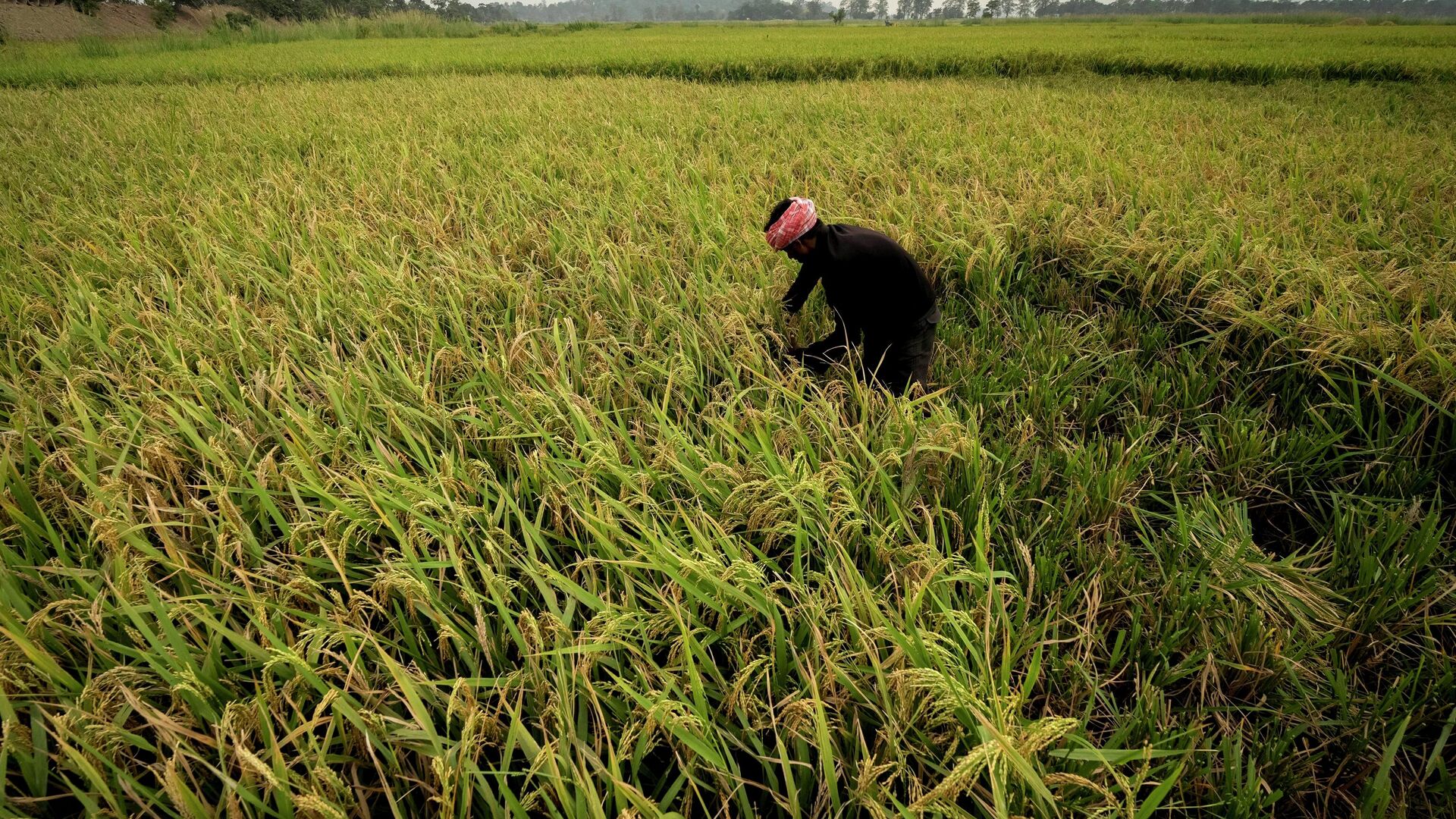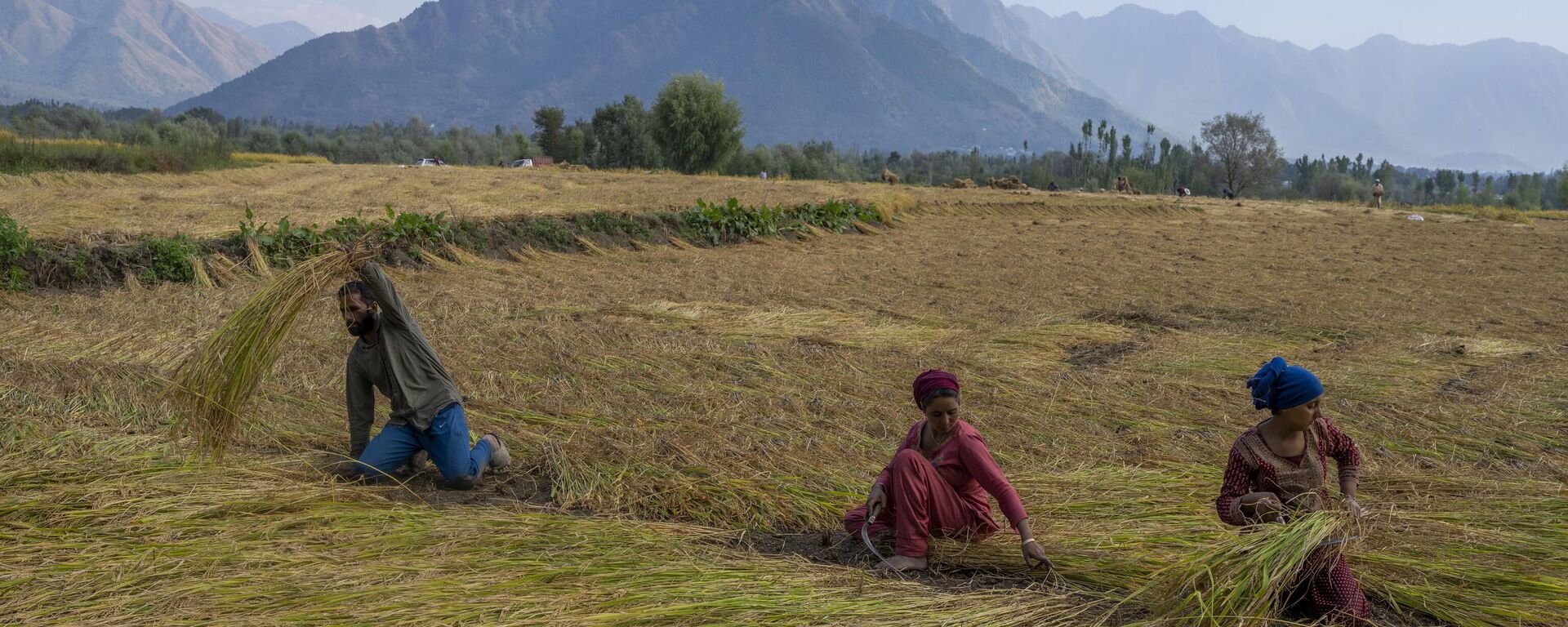https://sputniknews.in/20231228/india-reportedly-mulls-introducing-bharat-rice-will-it-help-tackle-inflation-6005403.html
India Reportedly Mulls Introducing Bharat Rice: Will It Help Tackle Inflation?
India Reportedly Mulls Introducing Bharat Rice: Will It Help Tackle Inflation?
Sputnik India
Media reports indicate that Delhi is planning to introduce a scheme under which it plans to sell rice at a discounted rate of INR 25 ($0.30) per kg. 28.12.2023, Sputnik India
2023-12-28T20:19+0530
2023-12-28T20:19+0530
2023-12-29T01:11+0530
india
bharatiya janata party (bjp)
food
staple food
food security
food insecurity
free food scheme
food crisis
free foodgrains
vegetarian food
https://cdn1.img.sputniknews.in/img/07e7/08/12/3683712_0:160:3072:1888_1920x0_80_0_0_1f81d2965b45bda22c68110189702d54.jpg
India's ruling Bharatiya Janata Party (BJP) is purportedly all set to sell Bharat rice at a subsidized price under its new inflation-tackling campaign ahead of next year's elections, media reports have suggested.The average retail price of rice has skyrocketed to INR 43.3 ($0.52) per kg, marking a staggering fourteen percent surge compared to the previous year, Center for Monitoring the Indian Economy (CMIE) data has suggested.Meanwhile, in November, India’s cereal inflation rate was 10.27%, a fifteen-month high.What is Bharat Food?To control food prices in the market, the federal government earlier introduced Bharat cereal and Bharat pulses, under which they sell food items at cheaper rates than the market price.In November, the government introduced Bharat Atta (fortified wheat flour). The flour was made available across the country through 700 mobile vans and 2,000 government-operated outlets. Bharat is the Hindi word for India.Why Controlling Food Inflation is Important?Speaking about such government initiatives, Ajit Jha, assistant professor with the Institute for Studies In Industrial Development, said, “The sale of Bharat initiative is attracting consumer interest, and the government is actively taking to ensure that the price of food items remain within its check. Curtailing food price inflation is important as it affects the consumers directly.” The professor argued that a large part of the country’s population still spends more than 50% of their earnings on food. "Hence, controlling food prices, especially wheat, rice and cereals, is essential for any government." Jha also opined that as the 2024 national elections are nearing, ignoring food inflation around this year would be very unwise for any government.“In the past, we have seen that National Democratic Alliance (which includes the BJP) lost elections due to high onion prices,” Jha shared. Meanwhile, the Indian government is already providing free food grain to 800 million people under the Pradhan Mantri Garib Kalyan Anna Yojana (PMGKAY); it is also one of the largest schemes in the world by any government.Will Bharat Scheme Help Curb Inflation? Experts remained tight-lipped over the matter, as many opined that despite the launch of subsidized cereals, pulses and wheat flour have not come down.Consumer Affairs Secretary Rohit Singh told the Indian news website Money Control that although the price is not down yet, it has started plateauing, and the government is strictly observing the trend, adding that the government aims to bring the price of pulses under control by February.However, Jha stressed that in schemes like Bharat or PMKGAY, the government is trying to directly connect with poor people and “directly entering into the market to sell rice through Open Market Sale Scheme (OMSS) to provide the maximum benefits to consumers.”Devendra Pant, chief economist at India Ratings, shared his doubt over selling subsidized food, adding that economic growth figures may not accurately represent the situation at the bottom of the income pyramid.Speaking on numbers, Pant said that he expects a decline in the Consumer Price Index (CPI) to 4% by the end of 2024-25, however, he expects inflation to average around 5.2-5.3% for 2023-24.
https://sputniknews.in/20231106/no-shortage-of-rice-production-in-india-expert-5268309.html
india
Sputnik India
feedback.hindi@sputniknews.com
+74956456601
MIA „Rossiya Segodnya“
2023
Deexa Khanduri
https://cdn1.img.sputniknews.in/img/07e6/0c/13/138923_52:0:533:481_100x100_80_0_0_cadf23d341691fc65ff2b22fd1afe584.jpg
Deexa Khanduri
https://cdn1.img.sputniknews.in/img/07e6/0c/13/138923_52:0:533:481_100x100_80_0_0_cadf23d341691fc65ff2b22fd1afe584.jpg
News
en_IN
Sputnik India
feedback.hindi@sputniknews.com
+74956456601
MIA „Rossiya Segodnya“
Sputnik India
feedback.hindi@sputniknews.com
+74956456601
MIA „Rossiya Segodnya“
Deexa Khanduri
https://cdn1.img.sputniknews.in/img/07e6/0c/13/138923_52:0:533:481_100x100_80_0_0_cadf23d341691fc65ff2b22fd1afe584.jpg
cheap rice, bharat rice, india’s cereal inflation, what is bharat brand, bharat cereal, bharat atta, bharat pulses, why controlling food inflation is important, ajit jha, assistant professor with the institute for studies in industrial development, bharat initiative, food price inflation, national democratic alliance, pradhan mantri garib kalyan anna yojana, pmgkay, will bharat scheme help to curb inflation?, consumer affairs secretary rohit singh, open market sale scheme, omss, open rice selling
cheap rice, bharat rice, india’s cereal inflation, what is bharat brand, bharat cereal, bharat atta, bharat pulses, why controlling food inflation is important, ajit jha, assistant professor with the institute for studies in industrial development, bharat initiative, food price inflation, national democratic alliance, pradhan mantri garib kalyan anna yojana, pmgkay, will bharat scheme help to curb inflation?, consumer affairs secretary rohit singh, open market sale scheme, omss, open rice selling
India Reportedly Mulls Introducing Bharat Rice: Will It Help Tackle Inflation?
20:19 28.12.2023 (Updated: 01:11 29.12.2023) Deexa Khanduri
Sputnik correspondent
Media reports indicate that Delhi is planning to introduce a scheme under which it plans to sell rice at a discounted rate of INR 25 ($0.30) per kg.
India's ruling Bharatiya Janata Party (BJP) is purportedly all set to sell Bharat rice at a subsidized price under its new inflation-tackling campaign ahead of next year's elections, media reports have suggested.
The average retail price of rice has skyrocketed to INR 43.3 ($0.52) per kg, marking a staggering fourteen percent surge compared to the previous year, Center for Monitoring the Indian Economy (CMIE) data has suggested.
Meanwhile, in November, India’s cereal inflation rate was 10.27%, a fifteen-month high.
To control food prices in the market, the
federal government earlier introduced Bharat cereal and Bharat pulses, under which they sell food items at cheaper rates than the market price.
In November, the government introduced Bharat Atta (fortified wheat flour). The flour was made available across the country through 700 mobile vans and 2,000 government-operated outlets. Bharat is the Hindi word for India.
Why Controlling Food Inflation is Important?
Speaking about such government initiatives, Ajit Jha, assistant professor with the Institute for Studies In Industrial Development, said, “The sale of Bharat initiative is attracting consumer interest, and the government is actively taking to ensure that the price of food items remain within its check. Curtailing food price inflation is important as it affects the consumers directly.”
The professor argued that a large part of the
country’s population still spends more than 50% of their earnings on food. "Hence, controlling food prices, especially wheat, rice and cereals, is essential for any government."
Jha also opined that as the 2024 national elections are nearing, ignoring food inflation around this year would be very unwise for any government.
“In the past, we have seen that National Democratic Alliance (which includes the BJP) lost elections due to high onion prices,” Jha shared.
Meanwhile, the Indian government is already providing free food grain to 800 million people under the Pradhan Mantri Garib Kalyan Anna Yojana (PMGKAY); it is also one of the largest schemes in the world by any government.
Will Bharat Scheme Help Curb Inflation?
Experts remained tight-lipped over the matter, as many opined that despite the launch of subsidized cereals, pulses and wheat flour have not come down.
Consumer Affairs Secretary Rohit Singh told the Indian news website Money Control that although the price is not down yet, it has
started plateauing, and the government is strictly observing the trend, adding that the government aims to bring the price of pulses under control by February.
However, Jha stressed that in schemes like Bharat or PMKGAY, the government is trying to directly connect with poor people and “directly entering into the market to sell rice through Open Market Sale Scheme (OMSS) to provide the maximum benefits to consumers.”
Devendra Pant, chief economist at India Ratings, shared his doubt over selling subsidized food, adding that
economic growth figures may not accurately represent the situation at the bottom of the income pyramid.
Speaking on numbers, Pant said that he expects a decline in the Consumer Price Index (CPI) to 4% by the end of 2024-25, however, he expects inflation to average around 5.2-5.3% for 2023-24.



